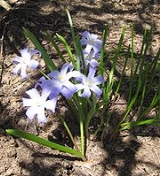
Chionodoxa luciliae
Encyclopedia
Chionodoxa luciliae or Lucile's Glory-of-the-snow is a bulbous
perennial
from west Turkey
flowering in early spring. After flowering, it goes into dormancy
until the next spring. The Latin name is in honour of Lucile, the wife of the Swiss botanist Pierre Edmond Boissier
.
Like all members of the genus Chionodoxa
, the bases of the stamen
s are flattened and closely clustered in the middle of the flower. In the related genus Scilla
, the stamens are not flattened or clustered together. The differences are not considered by some botanists as sufficient to create a separate genus, so they include this species in Scilla.
Each bulb produces two leaves, up to 8 cm long and 2 cm wide, and at most one flowering stem, up to 10 cm long. The flowers are produced in a loose pyramidal raceme
, with 2-3 flowers per stem, which face upwards. Each flower is up to 3.5 cm across. The base of each tepal
is white (as are the stamen filaments), producing a white 'eye'. The outer part of the tepals is violet-blue. The species can be distinguished from the commonest form grown in gardens, C. siehei
, by the much smaller number of slightly larger flowers per stem.
Bulb
A bulb is a short stem with fleshy leaves or leaf bases. The leaves often function as food storage organs during dormancy.A bulb's leaf bases, known as scales, generally do not support leaves, but contain food reserves to enable the plant to survive adverse conditions. At the center of the bulb is...
perennial
Perennial plant
A perennial plant or simply perennial is a plant that lives for more than two years. The term is often used to differentiate a plant from shorter lived annuals and biennials. The term is sometimes misused by commercial gardeners or horticulturalists to describe only herbaceous perennials...
from west Turkey
Turkey
Turkey , known officially as the Republic of Turkey , is a Eurasian country located in Western Asia and in East Thrace in Southeastern Europe...
flowering in early spring. After flowering, it goes into dormancy
Ephemeral Plant
An ephemeral plant is one marked by short life cycles, usually six to eight weeks. The word ephemeral means transitory or quickly fading. In regards to plants, it refers to several distinct growth strategies...
until the next spring. The Latin name is in honour of Lucile, the wife of the Swiss botanist Pierre Edmond Boissier
Pierre Edmond Boissier
Pierre Edmond Boissier was a Swiss botanist, explorer and mathematician.He was the son of Jacques Boissier and Lucile Butini , daughter of Pierre Butini a well-known physician and naturalist from Geneva...
.
Like all members of the genus Chionodoxa
Chionodoxa
Chionodoxa ' is a small genus of bulbous perennials in the family Asparagaceae, subfamily Scilloideae. The genus is endemic to the eastern Mediterranean region, specifically Crete, Cyprus and Turkey. The blue, white or pink flowers appear early in the year making them valuable garden ornamentals...
, the bases of the stamen
Stamen
The stamen is the pollen producing reproductive organ of a flower...
s are flattened and closely clustered in the middle of the flower. In the related genus Scilla
Scilla
Scilla is a genus of about 50 bulb-forming perennial herbs in the family Asparagaceae, subfamily Scilloideae, native to woodlands, subalpine meadows, and seashores throughout Europe and Asia...
, the stamens are not flattened or clustered together. The differences are not considered by some botanists as sufficient to create a separate genus, so they include this species in Scilla.
Each bulb produces two leaves, up to 8 cm long and 2 cm wide, and at most one flowering stem, up to 10 cm long. The flowers are produced in a loose pyramidal raceme
Raceme
A raceme is a type of inflorescence that is unbranched and indeterminate and bears pedicellate flowers — flowers having short floral stalks called pedicels — along the axis. In botany, axis means a shoot, in this case one bearing the flowers. In a raceme, the oldest flowers are borne...
, with 2-3 flowers per stem, which face upwards. Each flower is up to 3.5 cm across. The base of each tepal
Tepal
Tepals are elements of the perianth, or outer part of a flower, which include the petals or sepals. The term tepal is more often applied specifically when all segments of the perianth are of similar shape and color, or undifferentiated, which is called perigone...
is white (as are the stamen filaments), producing a white 'eye'. The outer part of the tepals is violet-blue. The species can be distinguished from the commonest form grown in gardens, C. siehei
Chionodoxa siehei
Chionodoxa siehei or Siehe's Glory-of-the-Snow is a bulbous perennial from west Turkey flowering in early spring. After flowering, it goes into dormancy until the next spring. It seeds readily to form colonies.-Description:...
, by the much smaller number of slightly larger flowers per stem.

